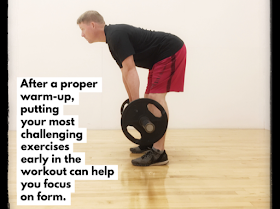You just checked off another workout! Great! Now you feel more accomplished to go get the rest of your week. One thing...you really didn't put the effort into the exercises that you should have. Meaning you probably won't see the benefits you are looking for from your exercise.
This list is made with various ideas to help you fix your form. By actually taking time to do the exercises right you can prevent injury, work the muscles you are actually targeting, and get the results you are after. Use this list for ideas of what to strengthen for better form, how to fix your form, and even ways to tell if you are doing your form correctly.
(Ideas all link to examples, equipment, how to, tips, or other fun ideas for form)
Start where you stand...and keep on stepping!
100 Ideas to Fix Your Form:
1. Use a Mirror
2. Warm-up Prior to Workout
3. Master Basic Exercises
4. Write Down Important Form Cues in Your Gym Journal
5. Have a Workout Partner
6. Strengthen Your Core
7. Breathe In During Load Phase; Breathe Out During Exertion
8. Place a Bench or Other Marker to Determine How Deep You are During Squat Movements
9. Refrain from Jerking or Using Momentum
10. Work on Your Balance
11. Make a Workout Program that is Progressive
12. Rest the Appropriate Time Between Sets So Your Form Does Not Fail
13. Utilize Stability Balls to Assist in Correct Mechanics for Some Exercises
14. Keep at Your Goal of Proper Form Daily
15. Go at a Slower Pace on Cardio Equipment Until You Master Form and/or are More Conditioned
16. Have a Spotter
17. Work on Your Agility
18. Use Machines to Help Guide Your Movements Until You Feel Comfortable Moving to Free Weight Exercises
19. Focus on Soft Landings During Plyometric Exercises
20. Choose Appropriate Exercises for Your Ability Level
21. Perform Plank Variation Exercises from a Raised Position to Focus on Form with Less Body Resistance
22. Strengthen Your Lats and Traps
23. Do Not Settle for Poor Form
24. Reduce the Amount of Weight You are Lifting
25. Wear Proper Footwear
26. Learn How to Maintain a Neutral Spine Throughout Movements
27. Work on Joint Mobility
28. Avoid Exercises that Aggravate a Resent Injury
29. Identify Goals to Fix Your Form
30. Become Familiar with the Basic Exercise Movements
31. Do Each Exercise as a Single Set so You Can Focus on Each Movement Individually
32. Use Kinetic Tape for Tendon/Ligament Support
33. Do Not Rush Through Your Workout
34. Learn to Look Forward or Slightly Forward to Maintain a Neutral Neck While Exercising
35. Practice Engaging Your Core Until it Becomes Second Nature
36. Refrain from Hunching Over on Cardio Equipment
37. Use Yoga Blocks to Aid You to Reach the Correct Pose Positioning
38. Research Common Form Fixes for Various Exercises
39. Master the Plank!
40. Focus on Single Planes of Movement
41. Perform High Repetition, Low Weight Sets to Focus on Form
42. Use a Push-up Trainer Mat
43. Strengthen the Muscles of Your Lower Back
44. Learn the Difference Between Soft Knees and Hyperextended Knees
45. Put Your Most Challenging Form Exercises First While You are Fresh
46. Eliminate Distractions So You Can Concentrate on the Movement
47. Use Suspension Trainer for Support
48. Perform Dynamic Movements to Prime Your Muscles for Resistance Exercises
49. Work on Posture Exercises
50. Focus on One Form Fix Per Workout
51. Choose a Weight You Can Control Throughout the Exercise
52. Keep a Gym Journal to Document any Areas Needed for Improvement
53. Control Your Breathing
54. Strengthen Your Stabilizing Muscles
55. Simplify Complex Movements
56. Begin with Myofascial Release Before you Warm-up
57. Practice Maintaining Form During Isometric Exercises
58. Eliminate Exercises that are Not Natural Movements
59. Focus on Time Under Tension Rather than Exercise Speed
60. Video Your Exercises to Verify Form (Robert's form is on point, but mine may need work)
61. Use a Yoga Strap to Help You Maintain the Correct Stretch Position
62. Practice Proper Posture While Sitting at Your Desk
63. Use a Wall or Chair to Maintain a Single Plane of Movement
64. Gradually Increase Your Range of Motion on Exercises
65. Know Which Muscles Need to be Utilized for Each Movement
66. Hire a Personal Trainer
67. Do High Impact Exercises in the Pool to Focus on Form and Power with Less Stress
68. Use a Basketball to Practice Medicine Ball Exercises Before Adding Resistance
69. Learn How to Use Your Core for Dynamic Movements Before Doing Resistance Power Moves Like Kettlebell Swings
70. Aim for a Healthy Body Composition
71. Focus on Full Range of Motion for Each Exercise Movement
72. Learn to Keep Your Chest Up, Shoulders Back for Numerous Exercise Movements: Stand Tall
73. Do Farmers Walks and Other Resistance Carries
74. Watch a Demonstration of Correct Form
75. Work on Your Flexibility
76. Hold Load/Isometric Phase for a Two Count
77. Do Functional Training Workouts
78. Use Resistance Bands to Practice Cable Exercises
79. Perfect Hip Hinge Form Before Ever Adding Resistance
80. Practice! Practice! Practice!
81. Condition Your Body
82. Perform Movements Seated, Kneeling, or Supine to Reduce Body Weight
83. Make Cues Relatable (Like Squeezing a Pencil Between Your Shoulder Blades for a Pull Exercise)
84. Do Not Be Afraid to Use Exercise Modifications When Needed
85. Make a Cardio Warm-up with Running Form Exercise (Like High Knees and Butt Kicks)
86. Listen to Verbal Cues as You Exercise
87. Perform Bodyweight Variation Before Resistance Variation
88. Strengthen Muscles for More Complex Exercises
89. Wear a Brace for Joint Support
90. Maintain a Consistent Cadence
91. Remember, "It's Not How Much You're Lifting, But How Well You Do It!"
92. Use a Dowel Rod to Practice Bar Exercise Movements
93. Aim to Maintain a Natural Stride on the Treadmill, but Hold on to Handles for Balances if Needed
94. For Heavy Olympic Leg Lifts be Sure to Rack the Bar at the Appropriate Height
95. Repeat Certain Form Cues to Yourself as You Perform the Exercise
96. Identify Three Exercises Your Form is Weak and Work Toward Mastering Those Movements
97. Recognize That Your Form Needs Work
98. Progress from Simple to More Complicated Exercises
99. Use a Smith Machine to Learn How to Keep the Bar in a Single Plane of Movement
100. Did I Mention Practice!
For daily fitspiration follow @soleshaping on:
Sole Shaping Blog is written by a nationally certified personal trainer, however, the topics and information given might not be specific for your health and wellness needs. The blog is intended for informational purposes only and not direct health advice. Consult with a doctor before beginning an exercise program or changing your nutritional diet. The blog is accurate and true to the best of my knowledge, but omissions, errors or mistakes may occur.
This website contains affiliate marketing ads which means if you follow a link and make a purchase, we receive small compensation at no extra cost to you.













